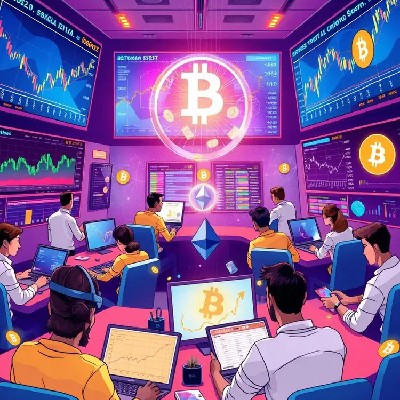Bitget: Top 4 toàn cầu về khối lượng giao dịch hàng ngày!
Thị phần BTC61.29%
Niêm yết mới trên Bitget : Pi Network
BTC/USDT$82345.97 (-0.15%)Chỉ số Sợ hãi và Tham lam32(Sợ hãi)
Chỉ số altcoin season:0(Bitcoin season)
Coin được niêm yết trên Thị trường sớmPAWS,WCTTổng dòng tiền ròng Bitcoin spot ETF -$93.2M (1 ngày); +$445.2M (7 ngày).Gói quà chào mừng dành cho người dùng mới trị giá 6200 USDT.Nhận ngay
Giao dịch mọi lúc, mọi nơi với ứng dụng Bitget. Tải xuống ngay
Bitget: Top 4 toàn cầu về khối lượng giao dịch hàng ngày!
Thị phần BTC61.29%
Niêm yết mới trên Bitget : Pi Network
BTC/USDT$82345.97 (-0.15%)Chỉ số Sợ hãi và Tham lam32(Sợ hãi)
Chỉ số altcoin season:0(Bitcoin season)
Coin được niêm yết trên Thị trường sớmPAWS,WCTTổng dòng tiền ròng Bitcoin spot ETF -$93.2M (1 ngày); +$445.2M (7 ngày).Gói quà chào mừng dành cho người dùng mới trị giá 6200 USDT.Nhận ngay
Giao dịch mọi lúc, mọi nơi với ứng dụng Bitget. Tải xuống ngay
Bitget: Top 4 toàn cầu về khối lượng giao dịch hàng ngày!
Thị phần BTC61.29%
Niêm yết mới trên Bitget : Pi Network
BTC/USDT$82345.97 (-0.15%)Chỉ số Sợ hãi và Tham lam32(Sợ hãi)
Chỉ số altcoin season:0(Bitcoin season)
Coin được niêm yết trên Thị trường sớmPAWS,WCTTổng dòng tiền ròng Bitcoin spot ETF -$93.2M (1 ngày); +$445.2M (7 ngày).Gói quà chào mừng dành cho người dùng mới trị giá 6200 USDT.Nhận ngay
Giao dịch mọi lúc, mọi nơi với ứng dụng Bitget. Tải xuống ngay

Liên quan đến coin
Tính toán giá
Lịch sử giá
Dự đoán giá
Phân tích kỹ thuật
Hướng dẫn mua coin
Danh mục tiền điện tử
Máy tính lợi nhuận

Giá Boost Trump CampaignBTC
Chưa niêm yết
Coin định giá:
VND
Dữ liệu được lấy từ nhà cung cấp bên thứ ba. Trang này và thông tin được cung cấp không xác nhận cho bất kỳ loại tiền điện tử cụ thể nào. Bạn muốn giao dịch các coin đã niêm yết? Nhấp vào đây
₫0.001155+0.00%1D
Biểu đồ giá
Cập nhật mới nhất vào 2025-03-30 23:12:08(UTC+0)
Vốn hóa thị trường:--
Vốn hóa thị trường pha loãng hoàn toàn:--
Khối lượng (24h):--
Khối lượng 24h / Vốn hóa thị trường:0.00%
Giá cao 24h:₫0.001979
Giá thấp 24h:₫0.001979
Cao nhất mọi thời đại:₫0.2607
Thấp nhất mọi thời đại:₫0.001951
Nguồn cung lưu hành:-- BTC
Tổng nguồn cung:
420,690,000,000BTC
Tỷ lệ lưu hành:0.00%
Nguồn cung tối đa:
--BTC
Giá bằng BTC:1 BTC
Giá bằng ETH:0.{4}1016 ETH
Giá khi bằng vốn hóa thị trường BTC:
--
Giá khi bằng vốn hóa thị trường ETH:
--
Hợp đồng:
0x300e...e83b850(Ethereum)
Bạn cảm thấy thế nào về Boost Trump Campaign hôm nay?
Lưu ý: Thông tin này chỉ mang tính chất tham khảo.
Giá Boost Trump Campaign hôm nay
Giá trực tuyến của Boost Trump Campaign là ₫0.001155 mỗi (BTC / VND) hôm nay với vốn hoá thị trường là ₫0.00 VND. Khối lượng giao dịch 24 giờ là ₫0.00 VND. Giá BTC theo VND được cập nhật trên thời gian thực. Boost Trump Campaign là 0.00% trong 24 giờ qua. Có nguồn cung lưu hành là 0 .
Giá cao nhất của BTC là bao nhiêu?
BTC có mức giá cao nhất mọi thời đại (ATH) là ₫0.2607, được ghi nhận vào 2024-05-27.
Giá thấp nhất của BTC là bao nhiêu?
BTC có mức giá thấp nhất mọi thời đại (ATL) là ₫0.001951, được ghi nhận vào ngày 2025-01-13.
Dự đoán giá Boost Trump Campaign
Giá của BTC vào năm 2026 sẽ là bao nhiêu?
Dựa trên mô hình dự đoán hiệu suất giá lịch sử của BTC, giá BTC dự kiến sẽ đạt ₫0.001344 vào năm 2026.
Giá của BTC vào năm 2031 sẽ là bao nhiêu?
Trong năm 2031, giá BTC dự kiến sẽ thay đổi +39.00%. Đến cuối năm 2031, giá BTC dự kiến sẽ đạt ₫0.005869 với ROI tích lũy là +408.23%.
Lịch sử giá Boost Trump Campaign (VND)
Giá của Boost Trump Campaign là -99.24% trong năm qua. Giá cao nhất của tính bằng VND trong năm ngoái là ₫0.2607 và mức giá thấp nhất của tính bằng VND trong năm ngoái là ₫0.001951.
Thời gianBiến động giá (%) Giá thấp nhất
Giá thấp nhất Giá cao nhất
Giá cao nhất 
 Giá thấp nhất
Giá thấp nhất Giá cao nhất
Giá cao nhất 
24h+0.00%₫0.001979₫0.001979
7d-5.36%₫0.001968₫0.002105
30d-27.79%₫0.001951₫0.002797
90d-54.88%₫0.001951₫0.005000
1y-99.24%₫0.001951₫0.2607
Tất cả thời gian-99.24%₫0.001951(2025-01-13, 77 ngày trước )₫0.2607(2024-05-27, 308 ngày trước )
Thông tin thị trường Boost Trump Campaign
Lịch sử vốn hóa thị trường của Boost Trump Campaign
Vốn hóa thị trường Boost Trump Campaign ETF
₫2,472,219,928,914,587 Chi tiết ETF
Dòng tiền ròng Boost Trump Campaign ETF
₫937,071,420,314,460
Boost Trump Campaign nắm giữ
Ma trận phân phối nắm giữ Boost Trump Campaign
Boost Trump Campaign nắm giữ theo mức độ tập trung
Whale
Investor
Retail
Địa chỉ Boost Trump Campaign theo thời gian nắm giữ
Holder
Cruiser
Trader
Biểu đồ giá coinInfo.name (12) trực tiếp

Xếp hạng Boost Trump Campaign
Xếp hạng trung bình từ cộng đồng
5
Nội dung này chỉ dành cho mục đích thông tin.
BTC sang tiền nội địa
1 BTC đến MXN$01 BTC đến GTQQ01 BTC đến CLP$01 BTC đến UGXSh01 BTC đến HNLL01 BTC đến ZARR01 BTC đến TNDد.ت01 BTC đến IQDع.د01 BTC đến TWDNT$01 BTC đến RSDдин.01 BTC đến DOP$01 BTC đến MYRRM01 BTC đến GEL₾01 BTC đến UYU$01 BTC đến MADد.م.01 BTC đến OMRر.ع.01 BTC đến AZN₼01 BTC đến KESSh01 BTC đến SEKkr01 BTC đến UAH₴0
- 1
- 2
- 3
- 4
- 5
Cập nhật mới nhất vào 2025-03-30 23:12:08(UTC+0)
Tin tức về Boost Trump Campaign

Xác suất Cục Dự trữ Liên bang giữ nguyên lãi suất trong tháng Năm là 83,3%
Bitget•2025-03-30 22:46

Bitcoin hình thành Death Cross: Giảm xuống 74.000 đô la trước khi tăng lên 200.000 đô la?
Tapchibitcoin•2025-03-30 19:33

Có nên hoảng sợ khi chỉ số chính của Bitcoin gần chạm “vùng âm”?
Tapchibitcoin•2025-03-30 19:33
Mua thêm
Câu Hỏi Thường Gặp
Giá hiện tại của Boost Trump Campaign là bao nhiêu?
Giá trực tiếp của Boost Trump Campaign là ₫0 cho mỗi (BTC/VND) với vốn hóa thị trường hiện tại là ₫0 VND. Giá trị của Boost Trump Campaign trải qua những biến động thường xuyên do hoạt động liên tục 24/7 trên thị trường tiền điện tử. Giá hiện tại của Boost Trump Campaign trong thời gian thực và dữ liệu lịch sử khả dụng trên Bitget.
Khối lượng giao dịch 24 giờ của Boost Trump Campaign là bao nhiêu?
Trong 24 giờ qua, khối lượng giao dịch của Boost Trump Campaign là ₫0.00.
Giá cao nhất mọi thời đại của Boost Trump Campaign là bao nhiêu?
Giá cao nhất mọi thời đại của Boost Trump Campaign là ₫0.2607. Mức giá cao nhất mọi thời đại này là mức giá cao nhất của Boost Trump Campaign kể từ khi ra mắt.
Liệu tôi có thể mua Boost Trump Campaign trên Bitget?
Có, Boost Trump Campaign hiện đang khả dụng trên sàn giao dịch tập trung của Bitget. Để biết thêm chi tiết, vui lòng xem qua hướng dẫn Hướng dẫn mua của chúng tôi.
Tôi có thể nhận được thu nhập ổn định khi đầu tư vào Boost Trump Campaign không?
Như mọi người đều biết, Bitget cung cấp nền tảng giao dịch chiến lược, với các bot giao dịch thông minh để tự động hóa các giao dịch của bạn và kiếm lợi nhuận.
Tôi có thể mua Boost Trump Campaign ở đâu với mức phí thấp nhất?
Chúng tôi vui mừng thông báo nền tảng giao dịch chiến lược hiện đã có mặt trên sàn giao dịch Bitget. Bitget cung cấp mức phí giao dịch và độ sâu tốt hàng đầu trong ngành để đảm bảo lợi nhuận cho các khoản đầu tư của nhà giao dịch.
Tôi có thể mua tiền điện tử ở đâu?
Mục video — xác minh nhanh, giao dịch nhanh

Cách hoàn tất xác minh danh tính trên Bitget và bảo vệ bạn khỏi gian lận
1. Đăng nhập vào tài khoản Bitget của bạn.
2. Nếu bạn chưa quen với Bitget, hãy xem hướng dẫn của chúng tôi về cách tạo tài khoản.
3. Di chuột qua biểu tượng hồ sơ của bạn, nhấp vào "Chưa xác minh" và nhấn "Xác minh".
4. Chọn quốc gia hoặc khu vực phát hành và loại ID của bạn, sau đó làm theo hướng dẫn.
5. Chọn "Xác minh Di động" hoặc "PC" dựa trên sở thích của bạn.
6. Nhập thông tin chi tiết của bạn, gửi bản sao giấy tờ tùy thân và ảnh selfie.
7. Gửi đăng ký của bạn và chúc mừng, bạn đã hoàn tất xác minh danh tính!
Đầu tư tiền điện tử, bao gồm mua Boost Trump Campaign trực tuyến qua Bitget, có thể chịu rủi ro thị trường. Bitget cung cấp các phương thức đơn giản và thuận tiện để bạn mua Boost Trump Campaign, bên cạnh đó, chúng tôi cố gắng đưa thông tin đầy đủ đến người dùng của mình về từng loại tiền điện tử được cung cấp trên nền tảng. Tuy nhiên, chúng tôi sẽ không chịu trách nhiệm về các kết quả có thể phát sinh từ giao dịch mua Boost Trump Campaign của bạn. Trang này và các thông tin trong đó không được xem là chứng thực của bất kỳ loại tiền điện tử cụ thể nào.
Bitget Insights
BGUSER-ESZNU97V
5giờ
I think Pi is now align with BTC. First Pi move seems independent.
BTC-0.35%
MOVE-5.34%

Crypto_inside
5giờ
Doge coin ❌ Shiba inu. 💥😳
Dogecoin (DOGE) and Shiba Inu (SHIB) are two popular cryptocurrencies that originated as meme-based tokens but have since gained significant attention and market value.
Similarities:
1. Meme-based origins: Both DOGE and SHIB originated as meme-based tokens, with DOGE featuring the "Doge" Shiba Inu meme and SHIB featuring a similar Shiba Inu character.
2. Community-driven: Both cryptocurrencies have strong community support, with active user bases and dedicated followers.
3. Decentralized: Both DOGE and SHIB are decentralized cryptocurrencies, meaning that there is no central authority controlling them.
Differences:
1. Blockchain: DOGE is based on the Litecoin blockchain, while SHIB is an ERC-20 token built on the Ethereum blockchain.
2. Supply: DOGE has a total supply of 132.67 billion coins, while SHIB has a total supply of 1 quadrillion (1,000,000,000,000,000) tokens.
3. Use cases: DOGE is primarily used for peer-to-peer transactions and charitable donations, while SHIB is focused on building a decentralized ecosystem with various use cases, such as NFTs and DeFi applications.
4. Market capitalization: DOGE has a larger market capitalization than SHIB, with a market cap of around $25.31 billion compared to SHIB's market cap of around $7.47 billion.
Investment and Trading Considerations:
1. Volatility: Both DOGE and SHIB are highly volatile cryptocurrencies, with prices subject to rapid fluctuations.
2. Market sentiment: The prices of both cryptocurrencies are heavily influenced by market sentiment and community enthusiasm.
3. Adoption and use cases: The success of both cryptocurrencies will depend on their ability to develop and promote practical use cases and achieve widespread adoption.
In conclusion, while both DOGE and SHIB have their unique characteristics and features, they share a common meme-based origin and community-driven spirit. As with any investment or trading decision, it's essential to conduct thorough research and consider multiple factors before making a decision.
Thank you...🙂
$SHIB $DOGE $BTC $ETH $XRP $PI $BGB $ADA $SUNDOG $NEIROETH $DOGS $BCH $QTUM $COQ $AI $PONKE $PEPE $MEME
SUNDOG+0.93%
BTC-0.35%
BGUSER-6R9PPRUG
6giờ
$ IMT
In the world of cryptocurrency, market sentiment is one of the most important factors influencing the price action of any digital asset. Bearish sentiment, characterized by a general outlook of pessimism, can significantly impact a token's price. For $IMT , the prevailing bearish sentiment can be a signal of a potential market correction or downward price trend. This could be influenced by a variety of factors, including broader market conditions, technical indicators, or external developments that shift investor sentiment toward caution or fear.
In this deep dive, we'll explore the reasons behind the bearish sentiment surrounding $IMT and examine whether market corrections will impact its price. We will also look at how such sentiment can affect both short-term and long-term price movements and what traders and investors should watch out for.
1. What is Bearish Sentiment?
Bearish sentiment refers to a general feeling of pessimism in the market, where investors expect the price of an asset to fall. In the context of $IMT, bearish sentiment means that traders and investors expect the price of the token to decline due to a range of factors. This sentiment often leads to more selling than buying, as investors look to exit positions before prices fall further.
When bearish sentiment takes hold, the following factors can come into play:
Declining demand: Fewer investors are willing to buy the token at higher prices.
Increased selling pressure: More holders might want to liquidate their positions in anticipation of a decline.
Market fear and panic: Negative news, poor performance, or general uncertainty can cause panic selling, driving prices even lower.
2. Reasons Behind Bearish Sentiment in $IMT
There are several reasons why bearish sentiment might take hold for $IMT:
a) Broader Market Conditions
Global Economic Conditions: Like all cryptocurrencies, $IMT is susceptible to macroeconomic factors. If there is a global economic downturn, such as a recession, inflation fears, or rising interest rates, investors may pull back from riskier assets like cryptocurrencies. During periods of economic uncertainty, many investors opt for safe-haven assets such as gold or the US dollar, causing digital assets like $IMT to face downward pressure.
Crypto Market-Wide Bearish Trends: Sometimes, bearish sentiment around a specific cryptocurrency is driven by larger trends within the entire crypto market. If major cryptocurrencies like Bitcoin (BTC) or Ethereum (ETH) are experiencing a downturn, the effect tends to ripple across smaller altcoins, including $IMT. A general market correction can trigger a broad sell-off, leading to a decline in the value of $IMT as investors turn risk-averse.
b) Regulatory Concerns
The cryptocurrency market is still relatively young and under the scrutiny of regulators across the world. If there is negative news regarding regulatory crackdowns or governments introducing stringent regulations against cryptocurrencies, this can lead to panic and a rush to liquidate positions.
For $IMT, if its project faces regulatory hurdles or if it operates in a jurisdiction where crypto regulations are becoming more restrictive, this could create negative sentiment. Regulatory uncertainty can erode investor confidence and trigger a bearish trend in the token's price.
c) Weak Market Fundamentals
Project Development Delays: If $IMT fails to deliver on promised upgrades, integrations, or key partnerships, it can cause investors to lose confidence in the long-term potential of the project. A lack of updates or technical glitches might signal that the project is stagnating, which can trigger sell-offs.
Lack of Utility or Adoption: $IMT may face a scenario where its use case is questioned, or its adoption rate is slower than expected. Without clear utility or growing demand for the token, the market may begin to see $IMT as an underperforming asset, leading to a decrease in demand and ultimately price decline.
d) Whale Manipulation and Market Sentiment
Whales are large investors or entities that hold substantial amounts of $IMT. If a whale starts selling off large amounts of the token, it can trigger panic among smaller investors, leading to more selling. This sell-off by a few large holders can contribute to a cascading effect, where others follow suit and cause a significant price drop.
Negative sentiment can also be influenced by social media discussions or news outlets, which can exacerbate panic selling, further fueling the bearish trend.
e) Technical Indicators Signaling Weakness
Resistance Levels: If $IMT faces rejection at key resistance levels (a price point at which the token struggles to move past), this could signal the inability of buyers to push the price higher. This type of price action could create a technical bearish scenario, where traders expect the price to fall back to lower support levels.
Bearish Divergence in RSI: The Relative Strength Index (RSI) is a key momentum indicator. A bearish divergence occurs when the price of $IMT is making higher highs, but the RSI is making lower highs. This indicates that while the price is increasing, the momentum behind it is weakening, signaling potential for a reversal to the downside.
Death Cross: A Death Cross occurs when the short-term moving average (such as the 50-day MA) crosses below the long-term moving average (such as the 200-day MA). This technical pattern is often seen as a bearish signal, suggesting that the market sentiment is turning negative, which could lead to further price declines for $IMT.
3. The Impact of Market Corrections on $IMT's Price
A market correction refers to a temporary decline in the price of an asset (typically around 10% or more from its recent highs). For $IMT, a correction can occur due to a combination of factors, including broader market sell-offs, technical factors, and shifts in investor sentiment.
a) Short-Term Impact: Price Declines and Increased Volatility
Increased Volatility: During market corrections, prices often experience high volatility. For $IMT, this means that while its price could dip sharply in the short term, it may also experience large price swings as buyers look for buying opportunities during the dip, and sellers attempt to exit positions.
Fear and Panic: In the short term, bearish sentiment can trigger panic selling, causing $IMT’s price to rapidly fall. This can create a negative feedback loop, where declining prices cause further panic, leading to additional selling and further price declines.
b) Long-Term Impact: Resetting Expectations
Recalibrating Valuations: A market correction often serves as a period of price consolidation, where overvalued assets are brought back to more sustainable levels. If $IMT has been in an overbought condition, a correction could be beneficial by helping to reset unrealistic price expectations. Once this price correction occurs, $IMT might establish a more solid foundation for future growth.
Accumulation Opportunities: Corrections also provide a chance for long-term investors to accumulate tokens at a lower price. If $IMT has a strong use case and technological foundation, investors might view a correction as an opportunity to buy the dip and hold for future potential.
4. Indicators to Watch for Signs of a Bearish Trend
If bearish sentiment continues, there are several key indicators to watch for that will confirm a sustained downtrend or continued market correction for $IMT:
Breaking Support Levels: If $IMT breaks below important support levels, it could confirm a bearish trend. Watch for the price to close below key technical levels such as the 50-day or 200-day moving average or significant horizontal support.
Decreasing Volume: During a bearish trend, volume often declines, signaling that the buying interest has faded and that fewer participants are willing to enter at current price levels.
Increased Selling Pressure: A rise in selling volume or large sell-offs by whales can indicate that sentiment is shifting towards the negative, potentially leading to further price declines.
5. How Traders Can Respond to Bearish Sentiment
a) Risk Management Strategies
Stop-Loss Orders: To manage risk during a bearish trend, traders may want to implement stop-loss orders to automatically sell their $IMT holdings at a predetermined price, protecting them from further declines.
Hedging Positions: Traders can also hedge against bearish price movements by using options or futures contracts to take short positions on $IMT or use other assets as a hedge.
b) Waiting for Market Stabilization
In the event of a market correction, some traders prefer to wait until the market stabilizes before re-entering positions. A period of price consolidation can help determine if $IMT has found a new equilibrium price and is ready for a recovery.
Conclusion: Will Market Corrections Impact $IMT’s Price?
Bearish sentiment and market corrections can have a profound impact on the price of $IMT. If the broader market continues to show signs of weakness, $IMT may experience significant downward pressure, exacerbated by declining market confidence and technical indicators signaling a reversal. However, market corrections are also natural phases in asset price cycles and can present opportunities for long-term investors to acquire tokens at lower prices.
For traders and investors, it’s essential to carefully monitor technical signals, market sentiment, and broader economic factors to assess whether the bearish trend is short-lived or indicative of more prolonged price decline.
$IMT
BTC-0.35%
MOVE-5.34%

Mi$h_£va💸
6giờ
$ IMT
In the world of cryptocurrency, market sentiment is one of the most important factors influencing the price action of any digital asset. Bearish sentiment, characterized by a general outlook of pessimism, can significantly impact a token's price. For $IMT , the prevailing bearish sentiment can be a signal of a potential market correction or downward price trend. This could be influenced by a variety of factors, including broader market conditions, technical indicators, or external developments that shift investor sentiment toward caution or fear.
In this deep dive, we'll explore the reasons behind the bearish sentiment surrounding $IMT and examine whether market corrections will impact its price. We will also look at how such sentiment can affect both short-term and long-term price movements and what traders and investors should watch out for.
1. What is Bearish Sentiment?
Bearish sentiment refers to a general feeling of pessimism in the market, where investors expect the price of an asset to fall. In the context of $IMT, bearish sentiment means that traders and investors expect the price of the token to decline due to a range of factors. This sentiment often leads to more selling than buying, as investors look to exit positions before prices fall further.
When bearish sentiment takes hold, the following factors can come into play:
Declining demand: Fewer investors are willing to buy the token at higher prices.
Increased selling pressure: More holders might want to liquidate their positions in anticipation of a decline.
Market fear and panic: Negative news, poor performance, or general uncertainty can cause panic selling, driving prices even lower.
2. Reasons Behind Bearish Sentiment in $IMT
There are several reasons why bearish sentiment might take hold for $IMT:
a) Broader Market Conditions
Global Economic Conditions: Like all cryptocurrencies, $IMT is susceptible to macroeconomic factors. If there is a global economic downturn, such as a recession, inflation fears, or rising interest rates, investors may pull back from riskier assets like cryptocurrencies. During periods of economic uncertainty, many investors opt for safe-haven assets such as gold or the US dollar, causing digital assets like $IMT to face downward pressure.
Crypto Market-Wide Bearish Trends: Sometimes, bearish sentiment around a specific cryptocurrency is driven by larger trends within the entire crypto market. If major cryptocurrencies like Bitcoin (BTC) or Ethereum (ETH) are experiencing a downturn, the effect tends to ripple across smaller altcoins, including $IMT. A general market correction can trigger a broad sell-off, leading to a decline in the value of $IMT as investors turn risk-averse.
b) Regulatory Concerns
The cryptocurrency market is still relatively young and under the scrutiny of regulators across the world. If there is negative news regarding regulatory crackdowns or governments introducing stringent regulations against cryptocurrencies, this can lead to panic and a rush to liquidate positions.
For $IMT, if its project faces regulatory hurdles or if it operates in a jurisdiction where crypto regulations are becoming more restrictive, this could create negative sentiment. Regulatory uncertainty can erode investor confidence and trigger a bearish trend in the token's price.
c) Weak Market Fundamentals
Project Development Delays: If $IMT fails to deliver on promised upgrades, integrations, or key partnerships, it can cause investors to lose confidence in the long-term potential of the project. A lack of updates or technical glitches might signal that the project is stagnating, which can trigger sell-offs.
Lack of Utility or Adoption: $IMT may face a scenario where its use case is questioned, or its adoption rate is slower than expected. Without clear utility or growing demand for the token, the market may begin to see $IMT as an underperforming asset, leading to a decrease in demand and ultimately price decline.
d) Whale Manipulation and Market Sentiment
Whales are large investors or entities that hold substantial amounts of $IMT. If a whale starts selling off large amounts of the token, it can trigger panic among smaller investors, leading to more selling. This sell-off by a few large holders can contribute to a cascading effect, where others follow suit and cause a significant price drop.
Negative sentiment can also be influenced by social media discussions or news outlets, which can exacerbate panic selling, further fueling the bearish trend.
e) Technical Indicators Signaling Weakness
Resistance Levels: If $IMT faces rejection at key resistance levels (a price point at which the token struggles to move past), this could signal the inability of buyers to push the price higher. This type of price action could create a technical bearish scenario, where traders expect the price to fall back to lower support levels.
Bearish Divergence in RSI: The Relative Strength Index (RSI) is a key momentum indicator. A bearish divergence occurs when the price of $IMT is making higher highs, but the RSI is making lower highs. This indicates that while the price is increasing, the momentum behind it is weakening, signaling potential for a reversal to the downside.
Death Cross: A Death Cross occurs when the short-term moving average (such as the 50-day MA) crosses below the long-term moving average (such as the 200-day MA). This technical pattern is often seen as a bearish signal, suggesting that the market sentiment is turning negative, which could lead to further price declines for $IMT.
3. The Impact of Market Corrections on $IMT's Price
A market correction refers to a temporary decline in the price of an asset (typically around 10% or more from its recent highs). For $IMT, a correction can occur due to a combination of factors, including broader market sell-offs, technical factors, and shifts in investor sentiment.
a) Short-Term Impact: Price Declines and Increased Volatility
Increased Volatility: During market corrections, prices often experience high volatility. For $IMT, this means that while its price could dip sharply in the short term, it may also experience large price swings as buyers look for buying opportunities during the dip, and sellers attempt to exit positions.
Fear and Panic: In the short term, bearish sentiment can trigger panic selling, causing $IMT’s price to rapidly fall. This can create a negative feedback loop, where declining prices cause further panic, leading to additional selling and further price declines.
b) Long-Term Impact: Resetting Expectations
Recalibrating Valuations: A market correction often serves as a period of price consolidation, where overvalued assets are brought back to more sustainable levels. If $IMT has been in an overbought condition, a correction could be beneficial by helping to reset unrealistic price expectations. Once this price correction occurs, $IMT might establish a more solid foundation for future growth.
Accumulation Opportunities: Corrections also provide a chance for long-term investors to accumulate tokens at a lower price. If $IMT has a strong use case and technological foundation, investors might view a correction as an opportunity to buy the dip and hold for future potential.
4. Indicators to Watch for Signs of a Bearish Trend
If bearish sentiment continues, there are several key indicators to watch for that will confirm a sustained downtrend or continued market correction for $IMT:
Breaking Support Levels: If $IMT breaks below important support levels, it could confirm a bearish trend. Watch for the price to close below key technical levels such as the 50-day or 200-day moving average or significant horizontal support.
Decreasing Volume: During a bearish trend, volume often declines, signaling that the buying interest has faded and that fewer participants are willing to enter at current price levels.
Increased Selling Pressure: A rise in selling volume or large sell-offs by whales can indicate that sentiment is shifting towards the negative, potentially leading to further price declines.
5. How Traders Can Respond to Bearish Sentiment
a) Risk Management Strategies
Stop-Loss Orders: To manage risk during a bearish trend, traders may want to implement stop-loss orders to automatically sell their $IMT holdings at a predetermined price, protecting them from further declines.
Hedging Positions: Traders can also hedge against bearish price movements by using options or futures contracts to take short positions on $IMT or use other assets as a hedge.
b) Waiting for Market Stabilization
In the event of a market correction, some traders prefer to wait until the market stabilizes before re-entering positions. A period of price consolidation can help determine if $IMT has found a new equilibrium price and is ready for a recovery.
Conclusion: Will Market Corrections Impact $IMT’s Price?
Bearish sentiment and market corrections can have a profound impact on the price of $IMT. If the broader market continues to show signs of weakness, $IMT may experience significant downward pressure, exacerbated by declining market confidence and technical indicators signaling a reversal. However, market corrections are also natural phases in asset price cycles and can present opportunities for long-term investors to acquire tokens at lower prices.
For traders and investors, it’s essential to carefully monitor technical signals, market sentiment, and broader economic factors to assess whether the bearish trend is short-lived or indicative of more prolonged price decline.
$IMT
BTC-0.35%
MOVE-5.34%

Crypto_inside
6giờ
Etherium Blocks ❌ Solana Blocks. 💥😳
Ethereum and Solana are two popular blockchain platforms that enable the creation of decentralized applications (dApps). Here's a comparison of their block structures:
Ethereum Blocks:
1. Block Time: Ethereum blocks are generated every 15 seconds on average.
2. Block Size: Ethereum blocks have a variable size, but the maximum size is around 8 million gas units.
3. Transactions: Ethereum blocks can contain multiple transactions, including smart contract executions and token transfers.
4. Gas Mechanism: Ethereum uses a gas mechanism to measure the computational effort required to execute transactions and smart contracts.
5. Block Reward: Ethereum's block reward is currently set at 2 ETH per block, plus transaction fees.
Solana Blocks:
1. Block Time: Solana blocks are generated every 400 milliseconds on average.
2. Block Size: Solana blocks have a variable size, but the maximum size is around 128 MB.
3. Transactions: Solana blocks can contain multiple transactions, including smart contract executions and token transfers.
4. Proof of History (PoH): Solana uses a proof-of-stake (PoS) consensus algorithm called Proof of History (PoH), which allows for faster block times and higher scalability.
5. Block Reward: Solana's block reward is currently set at 1.5 SOL per block, plus transaction fees.
Key Differences:
1. Block Time: Solana blocks are generated much faster than Ethereum blocks.
2. Block Size: Solana blocks can be larger than Ethereum blocks.
3. Scalability: Solana's PoH consensus algorithm allows for higher scalability than Ethereum's proof-of-work (PoW) consensus algorithm.
4. Gas Mechanism: Ethereum uses a gas mechanism, while Solana does not.
Thank you...🙂
$BTC $ETH $SOL $PI $ADA $BGB $XRP $ETC $AI $DOGS $SUNDOG $LTC $BCH $CATS $SHIB
SUNDOG+0.93%
BTC-0.35%
Tài sản liên quan
Tiền điện tử phổ biến
Lựa chọn 8 loại tiền điện tử hàng đầu theo vốn hóa thị trường.
Đã thêm gần đây
Các loại tiền điện tử đã được thêm gần đây nhất.
Vốn hóa thị trường tương đối
Trong tất cả các tài sản Bitget, 8 tài sản này có vốn hóa thị trường gần nhất với Boost Trump Campaign.




































